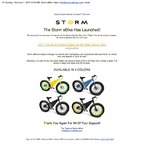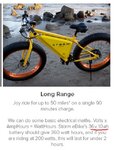Datapoints are all known as this is a known product not an unknown-invention such as the Kreyos Watch {another Agency 2.0 campaign} The problem is that the datapoints differ materially and significantly from the representations that were made.
There would be no controversy with the Ebike offering if the parties involved were committed to truthfulness. Truthfulness could be, and could have been, achieved by them at any time.
The problem is not with the bike (that will likely be delivered as a Chinese product is easily delivered), the problem now is with the conduct of the campaign as it relates to consumers (and the press) who know very little about the product.
(Post sales is also a major issue and guys such as Chris Nolte from Long Island Electric Bike, and many more people selling ebikes, can speak to that issue. I highly doubt that post sales concerns will be addressed which is a major part of purchasing an ebike, as it is also a major cost in selling these bikes.)
There has been a tremendous effort to misuse the press by having them echo the false claims of this campaign. 50 miles range has appeared prominently in prolific internet advertisements (without disclaimers - not that a disclaimer would offer anything but a rationalization for such a clearly false statement) and also in the Los Angeles Times (Yahoo Cnet etc) The Times may not have been aware of the false nature of this statement but the campaign certainly knows this number to be an impossibility.
The campaign (in the form of Agency 2.0 and also Indiegogo) have been actively and aggressively managing the information landscape. These entities are fully aware and alerted to these falsehoods and they refuse to remedy.
Unfortunately, The CPSC will only step in once people are injured, there is no law against bad business such as failing to have product liability insurance or post sales support, and consumers don't have the right to pursue false advertising claims under the Latham act.
False statements in advertising however are within the venue of the FTC. The FTC has also acknowledged that crowd-funding campaigns must conform to truth and advertising laws and standards that they set as a regulatory agency and which they administer. Both the advertiser and the agency could be held accountable by the FTC, the platform might also be considered a participant since they are offering "delivery insurance at a whopping 20+%" and thus have insight into the campaign.
If you care to file a concern about false or misleading advertising find this FTC complaint template as it can be used by you as a starting point;
The "Storm-Sondors crowdfunding" campaign has been centered around the sale of an electronic bicycle being sold to consumers for $499 (now $599) This campaign has raised near $3,750,000 in several days based on false representations made to the public and members of the press.
The product being sold is a known product with clearly documented parameters. Materially false and misleading statements were made as part of this campaign to include range, weight, specification, legality of operation (federal v state ) and expected performance.
Illustratively, the most brazenly-false representation made pertains to a claimed range of 50 miles versus a reality of approximately 15 miles or less. This claim has been widely published through advertisements appearing on the internet. This claim, among others that have been made, is and are irrefutably false.
The parties involved in this offering, individually separately together or in part, including Storm aka Sondors ebike, Indiegogo, and/or Agency 2.0 have continually refused to remedy the gross inaccuracies of this offering.
I hereby ask the Federal Trade Commission act in the public interest by remedying this situation through litigation.
https://www.ftccomplaintassistant.gov/GettingStarted?NextQID=251&Url=#&panel1-8#crnt
If you like, copy this post and send it to the FTC.. (or write your own based on facts) In the text name three parties.
Sondors ebike c/o Indiegogo 965 Mission Street, 6th Floor, San Francisco, CA 94103.
Indiegogo 965 Mission Street, 6th Floor, San Francisco, CA 94103.
Agency 2.0 co Indiegogo 965 Mission Street, 6th Floor, San Francisco, CA 94103.














